SEO
How to Create a Buyer Persona for Your Business
Looking to create a buyer persona for your business? You’re in the right place.
Many companies have experience creating buyer personas. It’s usually done after a day of brainstorming in a meeting room. After the session, documents with demographic and psychographic details (married, have two kids, own a car, etc.)—appear, and the executives are satisfied. They’re even given names—Anna Agency, Billy Blogger, etc.—to remind the marketing team that they’re marketing to actual human beings.
But these “buyer personas” are then tucked into the recesses of Google Drive, never to be seen again. You spend time “identifying” these personas, yet they have zero effect on any marketing activities.
“We don’t use our buyer personas, but here’s the doc we made.“
Why bother making it if you’re not going to use it?
Let’s build a buyer persona you’ll actually use!— Adrienne Barnes😊 (@AdrienneNakohl) January 10, 2022
Why? Because these buyer personas were not created in the right way. As such, they’re not helpful and can’t influence a company’s marketing strategy.
In this post, we’ll learn how to create a buyer persona that you can actually use to impact your business.
A buyer persona is a semi-fictional representation of your target customers. They’re semi-fictional because while they’re not actually real people, they’re based on market research and data you have about existing customers.
While every customer is different, it’s almost impossible for most companies to address all of them individually. (There are exceptions, however, which is why account-based marketing exists.)
However, buyers do generally have similar wants and needs. So, rather than cater to every individual difference, a buyer persona allows you to address those similarities in your marketing.
For example, a hobby blogger and an in-house marketer are entirely different people on the surface. But they do have a similar goal: to get more traffic to their website. So, rather than targeting them differently, we can address the main issue—how to get more traffic—and attract all of them to our business.
Also, since the buyer personas you’re creating are born out of actual stories related to your buyers, creating a buyer persona will help you understand your customers deeply—how they think and make decisions, who they’re influenced by, and so on.
This will help you create and align your messaging, product, customer service, etc., with what your customers actually want and need.
Finally, a buyer persona helps you visualize your buyers. Many companies make the mistake of focusing too inwards and forgetting who their products are serving. A buyer persona serves as a reminder that you are selling to actual people.
Creating a buyer persona isn’t about downloading a template and filling it in. It’s about talking to real people and understanding their perspectives.
Here’s how to create a buyer persona:
1. Find people to interview
Creating a buyer persona means picking up the phone (or, these days, a Zoom call) and talking to your customers.
That means the first step is to find people to interview. Who should you talk to? The easiest group of people to start with—and the ones you should start with—are your customers.
Finding them should be relatively easy. You should have a customer relationship management (CRM) tool where you store your customer data. Look through the list and pick out those you’d like to interview. A quick way to narrow the list is to find your best buyers—those who have been with you the longest or spent the most money with you.
If you’re just starting out and have no customers, don’t worry. You should have a general idea of who your product or service is for. Reach out to these people and see if they would be up for an interview. You can probably find them in their respective communities on Facebook, Telegram, Discord, Slack, Twitter, Reddit, etc. You can also consider attending physical events like conferences and meetups.
At an early stage, these interviews can simultaneously act as customer development interviews and help you determine product-market fit.
Now, while you should talk to your customers, note that talking only to them isn’t enough. After all, these people have bought from you and used your products or services. They’re clearly satisfied with what they’ve gotten. So, interviewing them might only yield stories where your business got it right.
Everyone wants to hear good things, but knowing where you came up short is also important. So, beyond your customers, there are other people you should interview. Here are some options:
A. Your users
Users are people who have started a trial with you or used a free version of your product but didn’t convert into a customer. You have users if you’re a SaaS or even a gym that offers a one-month trial.
Again, this group of people should be relatively easy to find as they would have submitted their contact details to access your trial or free product. For example, if we wanted to interview our users, we could easily find everyone who signed up for our free Ahrefs Webmaster Tools but is not currently a customer.

B. Your sales prospects
This group of people either reached out to your sales team (e.g., for a demo) or talked to your sales team but did not purchase your product. They may not necessarily be users.
Likewise, your sales team should have the details of these people. Work with your sales team to identify who they are and reach out to them.
2. Reach out to them for interviews
Once you’ve identified a list of people you’d like to talk to, send them an email and ask them if they’d like to hop on a call with you.
Be honest and transparent. Tell them directly that you’re trying to learn more about your customers and that you’d like to hear about their experience.
Make sure to state the time commitment upfront so you don’t scare them away. 20-30 minutes should suffice for the interview.
Also, assure them that it is not a sales call. Especially if you’re interviewing your users or sales prospects, they might be wary that you will use the opportunity to segue into a sales pitch.
Finally, you can offer an incentive to show appreciation for your customer’s time. It’ll also help encourage take-ups.
Adrienne Barnes of Best Buyer Persona says that she has found that discounts on your product (especially when talking to your customers) have yielded great success. Alternatively, charitable donations to your customer’s charity of choice (under their name) are also a great incentive idea to try.
3. Interview them
With the interviews scheduled, it’s time to do the actual interview.
Before the interview begins, ask if you can record it. This is important because we’re not going to lean on our unreliable memories to try and parse out insights. And while note-taking during the interview is essential, excessive note-taking disrupts the session.
When your interviewee has signified an “ok,” you can start.
Adele Revella of Buyer Persona Institute suggests that you begin with this question, “Take me back to the day when you first decided to evaluate [the category of solution your product fits into] and tell me what happened.”
This should set the tone and allow your interviewee to relate their experience.
You can also ask questions based on Adele Revella’s famous Five Rings of Buying Insight:
- Priority Initiatives — What’s causing buyers to invest in products like yours? What about buyers who are satisfied with the status quo?
- Success Factors — What results does your buyer expect to achieve from buying your (or a similar) product?
- Perceived Barriers — What concerns do your buyers have regarding your product? What’s stopping them from buying?
- Buyer’s Journey — How do buyers evaluate their options?
- Decision Criteria — Which aspects of your competitors do buyers consider the most important?
From there, follow these tips to ensure a smooth interview:
- Give interviewees time to respond. Your interviewees are not robots with prepared answers to every question. Silence is golden—give them space and time to think through their thoughts and respond.
- Listen. Don’t insert your own opinions or defend yourself or your products. Your goal is to find answers, not sell or be judged by a court of opinion. Make sure to listen to what your customers are saying.
- Ask “why” and ask follow-up questions based on what they’ve said (and use the words they’re using). Your interviewees may not answer your questions directly or fully. Or maybe they might need prodding to provide more information. Don’t be afraid to ask follow-up questions and get them to clarify what they’re saying. You want to be on the same page. Even better: use the words they’ve been using so you can build rapport with them and get them to open up more.
- Don’t be afraid to guide your interviewees. It is likely that they will not answer chronologically. They might skip ahead and add a flashback to their story. You should feel comfortable slowing down the pace and guiding them back to the part of the conversation you’re interested in.
4. Organize your data
When the interviews are over, you’d want to get them transcribed. Use a service like Rev.com to turn them into text.
Next, it’s time to mark up your interview transcripts. You can then read through the transcripts and identify patterns (such as commonly repeated words and phrases) among what your customers are saying.
When you see two or more of the same pattern, create a category for them. The easiest way to create these “categories” is via the marketing funnel.


For example, say we interviewed a few of our customers at Ahrefs. Reading through the transcripts, we noticed that one commonly repeated phrase was “we wanted to figure out how to rank in Google for more keywords related to our business.” Since we sell an SEO toolset, we could easily file that under the category of “Interest.”
You can do all of this in Google Sheets.


An alternative method of marking up the transcript is to follow the Five Rings of Buying Insights.
5. Create your buyer persona(s) by segmenting your data
Finally, you’d want to segment your data into different audiences.
Here are some ways you can segment your audience, courtesy of Adrienne Barnes:
- The “jobs to be done” your customers bought your product for
- Pain points
- Usage
- Company size
- Industry
Sometimes there are clearly two different people you can see popping out of your data. Sometimes, there’s clearly just one “job-to-be-done,” so you only have one persona. How you segment and how many segments you should create depends entirely on your business and customers. There’s no perfect way to go about it.
Once you’ve identified your segments, transfer them into a document(s) with all the relevant qualitative data.
The goal of creating your buyer persona is to use them in your marketing. Not store them somewhere and forget about them.
So, here’s how to use buyer personas:
1. Positioning
Positioning consultant April Dunford writes that “positioning is the act of deliberately defining how you are the best at something that a defined market cares a lot about.”
You can use the information you’ve gathered to fix or adjust your positioning with what your customers care about.
2. Creating content for the different stages of the buyer’s journey
To create content for the buyer’s journey, you need to know who the buyer is. And you need to know how they progress through each stage until they purchase your product.
You now have both pieces of information.
For example, let’s say we’ve created a buyer persona at Ahrefs. We’ll call him Billy Blogger. And here’s Billy Blogger’s journey:


In the Awareness stage, Billy is struggling with getting more traffic to his site. So, if we’re creating content for this stage, we’re looking for topics related to:
- Website traffic
- Blog traffic
Here’s how we can find topics related to this stage to target:
- Go to Ahrefs’ Keywords Explorer
- Enter the above terms
- Go to the Matching terms report
Since the “Awareness stage” keywords are mostly informational, we’ll switch the toggle to Questions.


As you can see, there are over 1,600 potential topics we can target. However, since not all of them will be relevant to us, we’ll eyeball the list and pick out relevant ones.
We can repeat this step to look for topics for the other stages of the buyer’s journey.
Recommended reading: What Is the Buyer’s Journey? How to Create Content for Every Stage
3. Alignment with sales and product teams
With the information from your buyer interviews, you can help your sales team anticipate buying barriers, create relevant marketing and sales materials, and prepare tools and arguments for moving customers towards purchase.
Likewise, it can also help your product teams create products that customers want and remove friction from how they use your product.
Here are some frequently asked questions about buyer personas.
1. How many buyer interviews should I do?
To kickstart your process, aim to conduct at least ten interviews. But bear in mind that buyer interviews are not a “campaign.” Ideally, you should be doing this every month—meeting buyers, interviewing them, getting real-life stories and quotes, and updating your buyer persona document (where necessary).
2. What questions should I ask in the interview?
There’s no fixed set of questions to ask. Most of it should come spontaneously and naturally since there should be follow-up questions based on what your interviewee says.
Other than that, you should also be constructing questions based on what you want to know. And this depends heavily on your business, product, customers, and the existing information you have.
However, if you really need a set of questions to ask (or at least use as inspiration), I like this list from Mike Fishbein.
3. Should I include demographics and psychographics in my buyer persona?
In the introduction, I poo-pooed the idea of adding these details to your buyer persona. But they’re not all that bad.
You can add them if they’re actually useful to your marketing. Although there are plenty of times, especially in B2B and software, where this information is not useful.
I love this.
I’ve always kinda hated how ‘personas’ in marketing get a lot of elevation as a ‘thing’. 🤷🏻♀️
Personas for hands-on marketers? Useless.
What’s useful? Understanding target customer PROBLEMS, not PERSONAS. 🥁 pic.twitter.com/bxoQYYQwBO
— Fi Shailes 🥁 (@Fi_digitaldrum) December 1, 2021
Think about it: If you’re selling a martech software, does it matter whether ‘Charlie CMO’ is married? If his partner is the CEO or CFO, it does, but that’s an exceptional circumstance. Usually, it won’t impact your marketing.
However, it is useful if you own a wedding photography business. A married person doesn’t need wedding photography services, so demographic information such as marital status would be helpful to such a business.
4. Can I do surveys instead of calling my customers?
I know. Picking up the phone or hopping onto Zoom calls can be intimidating. But there’s no substitute for actually talking to someone.
Plus, surveys have to be designed by someone. And that someone can only design a survey based on their existing knowledge. That means a survey can be subjected to the designer’s unintended bias and therefore fail to discover new or unexpected insights.
Sidenote.
Interview questions can be subject to the interviewer’s unintended bias too. So make sure that you create open-ended questions and leave them to your interviewee to answer in any way they like. Do not insert your opinion or try to guide them to the answer you want to hear.
You don’t want to conduct multiple surveys and end up only perpetuating your confirmation bias.
Instead, use surveys to validate the insights you acquired via your interviews. See if the comments given by your interviewees are one-off or representative of a larger audience set.
5. How many buyer personas should I create?
Adele Revella writes:
The fundamental question isn’t how many buyer personas are required, but rather how many ways do you need to market your solution so that you can persuade buyers that your approach is ideally suited to their needs?
We can achieve this goal only if the way we define our buyer personas makes it easy to know when a different version of our story will result in more business for the company.
This is the reason why we’re less concerned with demographics but more with the “job-to-be-done.” When you segment by demographics, it’s tempting to create every variation after the sun—after all, there isn’t just Charlie CMO; there’s also Claire CMO, Chantelle CMO, CMO Chen, and so on.
However, since they are CMOs, they will have similar “jobs-to-be-done.” And if you find that to be true from your interviews, you can create one buyer persona to target them all. But if you find that some expectations are different, then that’s when you can consider creating another buyer persona.
If you think that creating another buyer persona can help you market your product better—like what Adele Revella says—then consider investing some resources to conduct additional buyer interviews to “prove” that this persona exists. Surveys can work, too—use them to see if your current findings apply across all segments.
6. Should you interview the “final decision maker” (e.g., CMO, CFO, CEO)?
In many companies, especially large ones, —the final decision maker is a higher-up. And traditionally, many sales teams are taught to target the final decision maker to sell their products.
In that case, should you take cues from the sales team? Probably not. That is because while the “final decision maker” gives the ok to buy, they may not be involved much in the evaluation process.
If so, interviewing them (if they’re even available in the first place) will not yield much insight. You’re better off interviewing people who are involved.
Final thoughts
This post would not have been possible without the work of Adele Revella and Adrienne Barnes. If you’d like to explore more of their work, I recommend:
- Reading Adele Revella’s book, Buyer Personas
- Listening to this podcast episode, where Adrienne Barnes explains how to create buyer personas
Any questions or comments about creating buyer personas? Let me know on Twitter.
SEO
How To Write ChatGPT Prompts To Get The Best Results

ChatGPT is a game changer in the field of SEO. This powerful language model can generate human-like content, making it an invaluable tool for SEO professionals.
However, the prompts you provide largely determine the quality of the output.
To unlock the full potential of ChatGPT and create content that resonates with your audience and search engines, writing effective prompts is crucial.
In this comprehensive guide, we’ll explore the art of writing prompts for ChatGPT, covering everything from basic techniques to advanced strategies for layering prompts and generating high-quality, SEO-friendly content.
Writing Prompts For ChatGPT
What Is A ChatGPT Prompt?
A ChatGPT prompt is an instruction or discussion topic a user provides for the ChatGPT AI model to respond to.
The prompt can be a question, statement, or any other stimulus to spark creativity, reflection, or engagement.
Users can use the prompt to generate ideas, share their thoughts, or start a conversation.
ChatGPT prompts are designed to be open-ended and can be customized based on the user’s preferences and interests.
How To Write Prompts For ChatGPT
Start by giving ChatGPT a writing prompt, such as, “Write a short story about a person who discovers they have a superpower.”
ChatGPT will then generate a response based on your prompt. Depending on the prompt’s complexity and the level of detail you requested, the answer may be a few sentences or several paragraphs long.
Use the ChatGPT-generated response as a starting point for your writing. You can take the ideas and concepts presented in the answer and expand upon them, adding your own unique spin to the story.
If you want to generate additional ideas, try asking ChatGPT follow-up questions related to your original prompt.
For example, you could ask, “What challenges might the person face in exploring their newfound superpower?” Or, “How might the person’s relationships with others be affected by their superpower?”
Remember that ChatGPT’s answers are generated by artificial intelligence and may not always be perfect or exactly what you want.
However, they can still be a great source of inspiration and help you start writing.
Must-Have GPTs Assistant
I recommend installing the WebBrowser Assistant created by the OpenAI Team. This tool allows you to add relevant Bing results to your ChatGPT prompts.
This assistant adds the first web results to your ChatGPT prompts for more accurate and up-to-date conversations.
It is very easy to install in only two clicks. (Click on Start Chat.)
For example, if I ask, “Who is Vincent Terrasi?,” ChatGPT has no answer.
With WebBrower Assistant, the assistant creates a new prompt with the first Bing results, and now ChatGPT knows who Vincent Terrasi is.
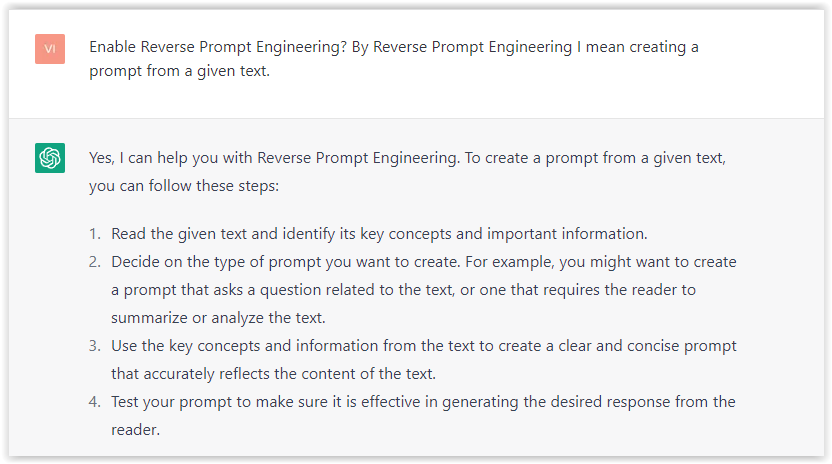 Screenshot from ChatGPT, March 2023
Screenshot from ChatGPT, March 2023You can test other GPT assistants available in the GPTs search engine if you want to use Google results.
Master Reverse Prompt Engineering
ChatGPT can be an excellent tool for reverse engineering prompts because it generates natural and engaging responses to any given input.
By analyzing the prompts generated by ChatGPT, it is possible to gain insight into the model’s underlying thought processes and decision-making strategies.
One key benefit of using ChatGPT to reverse engineer prompts is that the model is highly transparent in its decision-making.
This means that the reasoning and logic behind each response can be traced, making it easier to understand how the model arrives at its conclusions.
Once you’ve done this a few times for different types of content, you’ll gain insight into crafting more effective prompts.
Prepare Your ChatGPT For Generating Prompts
First, activate the reverse prompt engineering.
- Type the following prompt: “Enable Reverse Prompt Engineering? By Reverse Prompt Engineering I mean creating a prompt from a given text.”
 Screenshot from ChatGPT, March 2023
Screenshot from ChatGPT, March 2023ChatGPT is now ready to generate your prompt. You can test the product description in a new chatbot session and evaluate the generated prompt.
- Type: “Create a very technical reverse prompt engineering template for a product description about iPhone 11.”
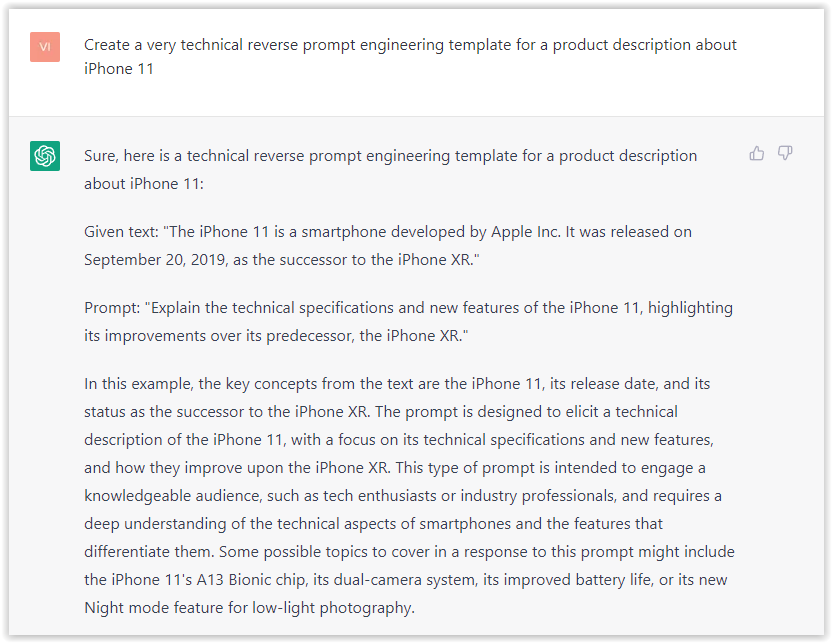 Screenshot from ChatGPT, March 2023
Screenshot from ChatGPT, March 2023The result is amazing. You can test with a full text that you want to reproduce. Here is an example of a prompt for selling a Kindle on Amazon.
- Type: “Reverse Prompt engineer the following {product), capture the writing style and the length of the text :
product =”
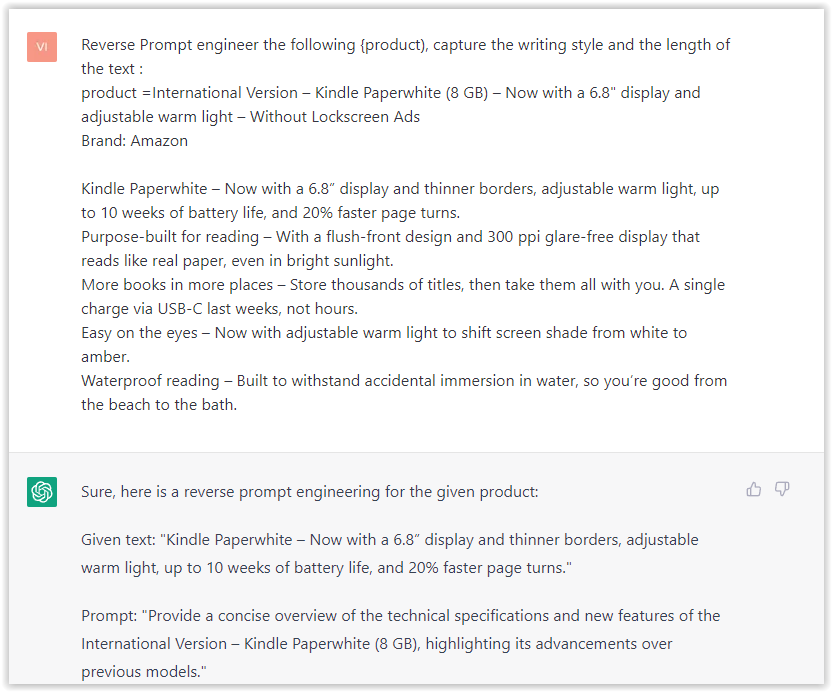 Screenshot from ChatGPT, March 2023
Screenshot from ChatGPT, March 2023I tested it on an SEJ blog post. Enjoy the analysis – it is excellent.
- Type: “Reverse Prompt engineer the following {text}, capture the tone and writing style of the {text} to include in the prompt :
text = all text coming from https://www.searchenginejournal.com/google-bard-training-data/478941/”
 Screenshot from ChatGPT, March 2023
Screenshot from ChatGPT, March 2023But be careful not to use ChatGPT to generate your texts. It is just a personal assistant.
Go Deeper
Prompts and examples for SEO:
- Keyword research and content ideas prompt: “Provide a list of 20 long-tail keyword ideas related to ‘local SEO strategies’ along with brief content topic descriptions for each keyword.”
- Optimizing content for featured snippets prompt: “Write a 40-50 word paragraph optimized for the query ‘what is the featured snippet in Google search’ that could potentially earn the featured snippet.”
- Creating meta descriptions prompt: “Draft a compelling meta description for the following blog post title: ’10 Technical SEO Factors You Can’t Ignore in 2024′.”
Important Considerations:
- Always Fact-Check: While ChatGPT can be a helpful tool, it’s crucial to remember that it may generate inaccurate or fabricated information. Always verify any facts, statistics, or quotes generated by ChatGPT before incorporating them into your content.
- Maintain Control and Creativity: Use ChatGPT as a tool to assist your writing, not replace it. Don’t rely on it to do your thinking or create content from scratch. Your unique perspective and creativity are essential for producing high-quality, engaging content.
- Iteration is Key: Refine and revise the outputs generated by ChatGPT to ensure they align with your voice, style, and intended message.
Additional Prompts for Rewording and SEO:
– Rewrite this sentence to be more concise and impactful.
– Suggest alternative phrasing for this section to improve clarity.
– Identify opportunities to incorporate relevant internal and external links.
– Analyze the keyword density and suggest improvements for better SEO.
Remember, while ChatGPT can be a valuable tool, it’s essential to use it responsibly and maintain control over your content creation process.
Experiment And Refine Your Prompting Techniques
Writing effective prompts for ChatGPT is an essential skill for any SEO professional who wants to harness the power of AI-generated content.
Hopefully, the insights and examples shared in this article can inspire you and help guide you to crafting stronger prompts that yield high-quality content.
Remember to experiment with layering prompts, iterating on the output, and continually refining your prompting techniques.
This will help you stay ahead of the curve in the ever-changing world of SEO.
More resources:
Featured Image: Tapati Rinchumrus/Shutterstock
SEO
Measuring Content Impact Across The Customer Journey
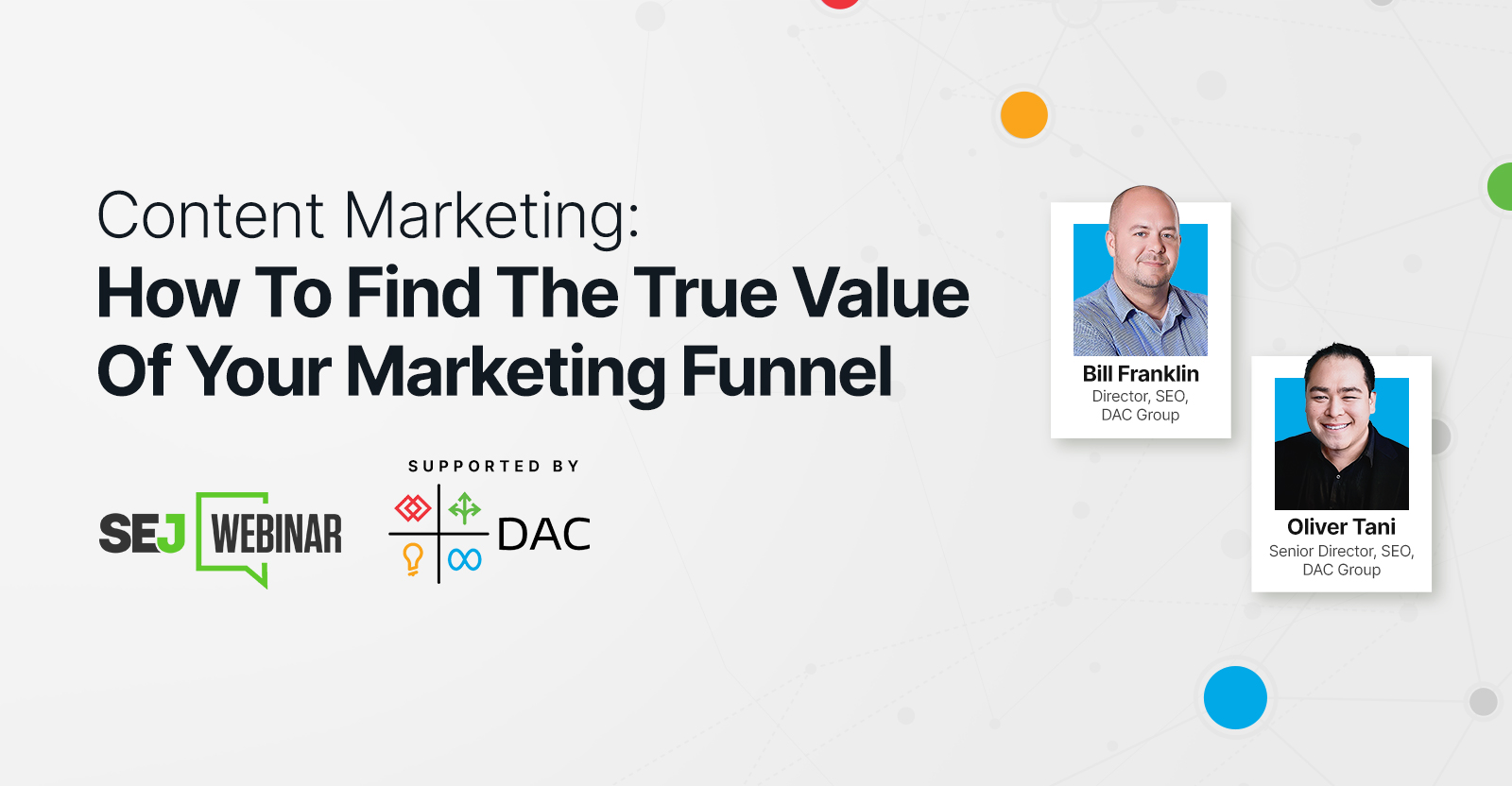
Understanding the impact of your content at every touchpoint of the customer journey is essential – but that’s easier said than done. From attracting potential leads to nurturing them into loyal customers, there are many touchpoints to look into.
So how do you identify and take advantage of these opportunities for growth?
Watch this on-demand webinar and learn a comprehensive approach for measuring the value of your content initiatives, so you can optimize resource allocation for maximum impact.
You’ll learn:
- Fresh methods for measuring your content’s impact.
- Fascinating insights using first-touch attribution, and how it differs from the usual last-touch perspective.
- Ways to persuade decision-makers to invest in more content by showcasing its value convincingly.
With Bill Franklin and Oliver Tani of DAC Group, we unravel the nuances of attribution modeling, emphasizing the significance of layering first-touch and last-touch attribution within your measurement strategy.
Check out these insights to help you craft compelling content tailored to each stage, using an approach rooted in first-hand experience to ensure your content resonates.
Whether you’re a seasoned marketer or new to content measurement, this webinar promises valuable insights and actionable tactics to elevate your SEO game and optimize your content initiatives for success.
View the slides below or check out the full webinar for all the details.
SEO
How to Find and Use Competitor Keywords
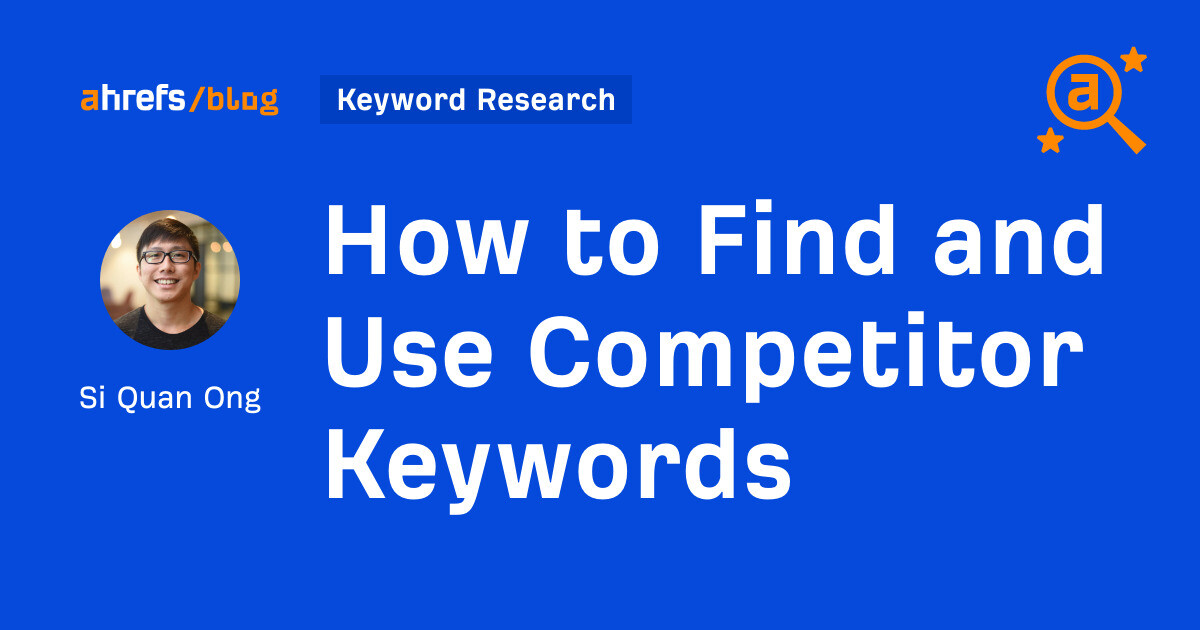
Competitor keywords are the keywords your rivals rank for in Google’s search results. They may rank organically or pay for Google Ads to rank in the paid results.
Knowing your competitors’ keywords is the easiest form of keyword research. If your competitors rank for or target particular keywords, it might be worth it for you to target them, too.
There is no way to see your competitors’ keywords without a tool like Ahrefs, which has a database of keywords and the sites that rank for them. As far as we know, Ahrefs has the biggest database of these keywords.
How to find all the keywords your competitor ranks for
- Go to Ahrefs’ Site Explorer
- Enter your competitor’s domain
- Go to the Organic keywords report
The report is sorted by traffic to show you the keywords sending your competitor the most visits. For example, Mailchimp gets most of its organic traffic from the keyword “mailchimp.”


Since you’re unlikely to rank for your competitor’s brand, you might want to exclude branded keywords from the report. You can do this by adding a Keyword > Doesn’t contain filter. In this example, we’ll filter out keywords containing “mailchimp” or any potential misspellings:
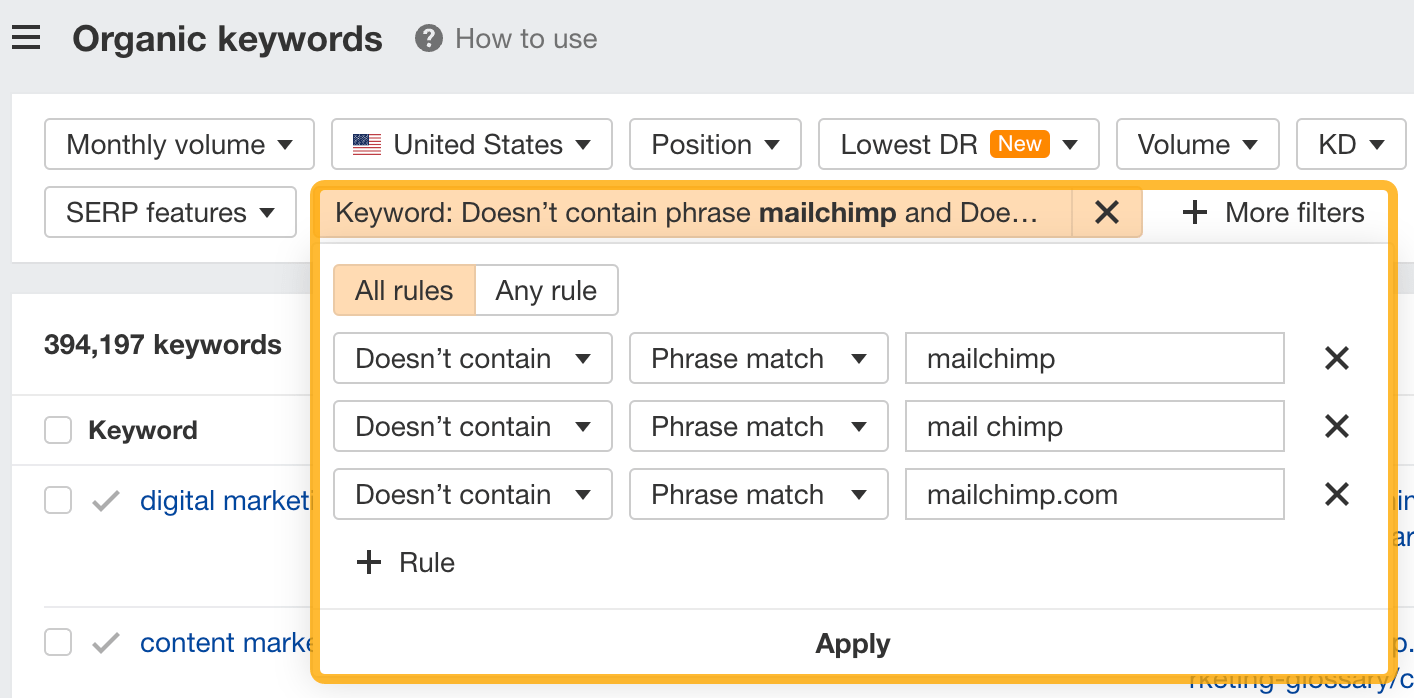

If you’re a new brand competing with one that’s established, you might also want to look for popular low-difficulty keywords. You can do this by setting the Volume filter to a minimum of 500 and the KD filter to a maximum of 10.
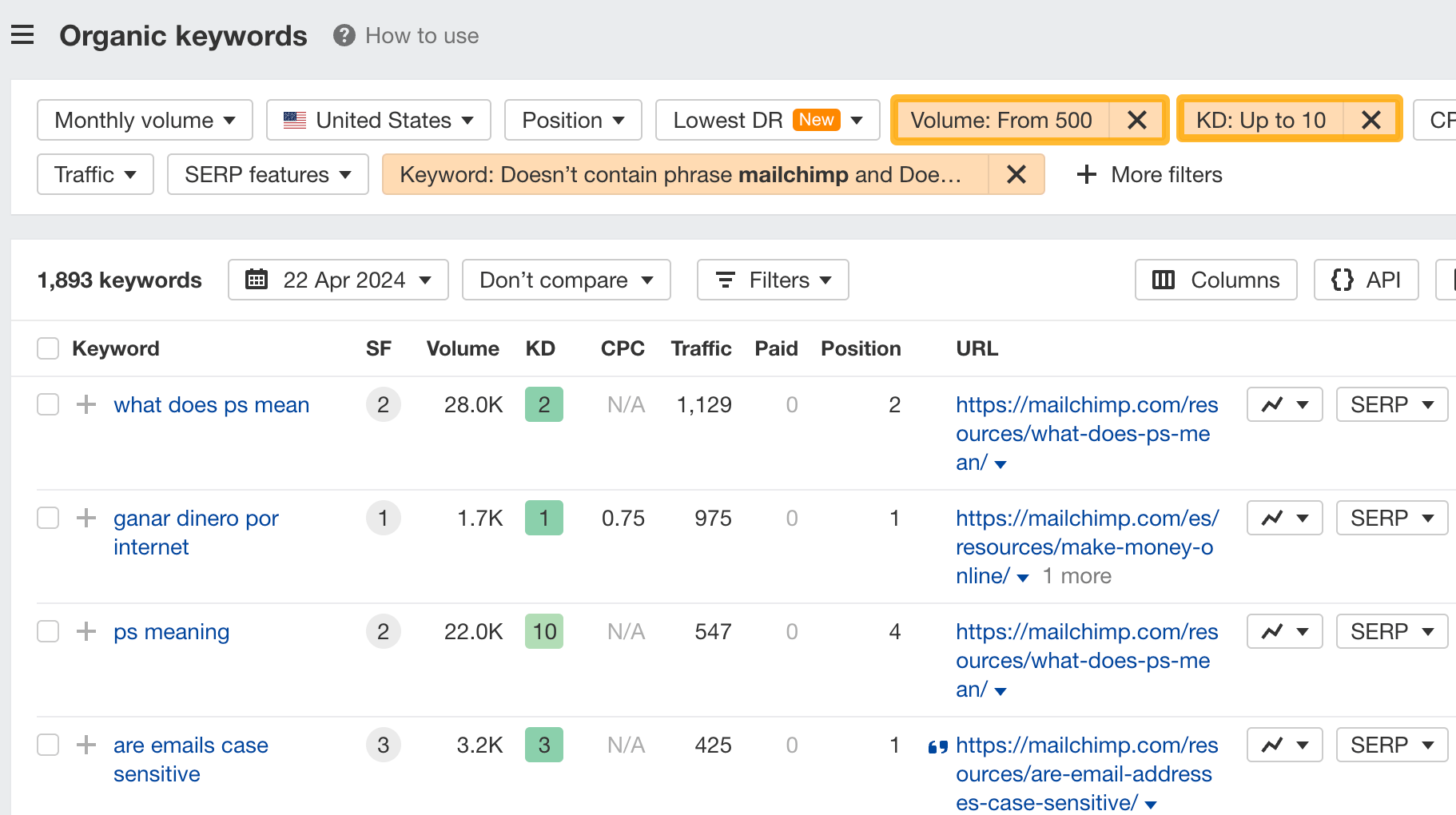

How to find keywords your competitor ranks for, but you don’t
- Go to Competitive Analysis
- Enter your domain in the This target doesn’t rank for section
- Enter your competitor’s domain in the But these competitors do section
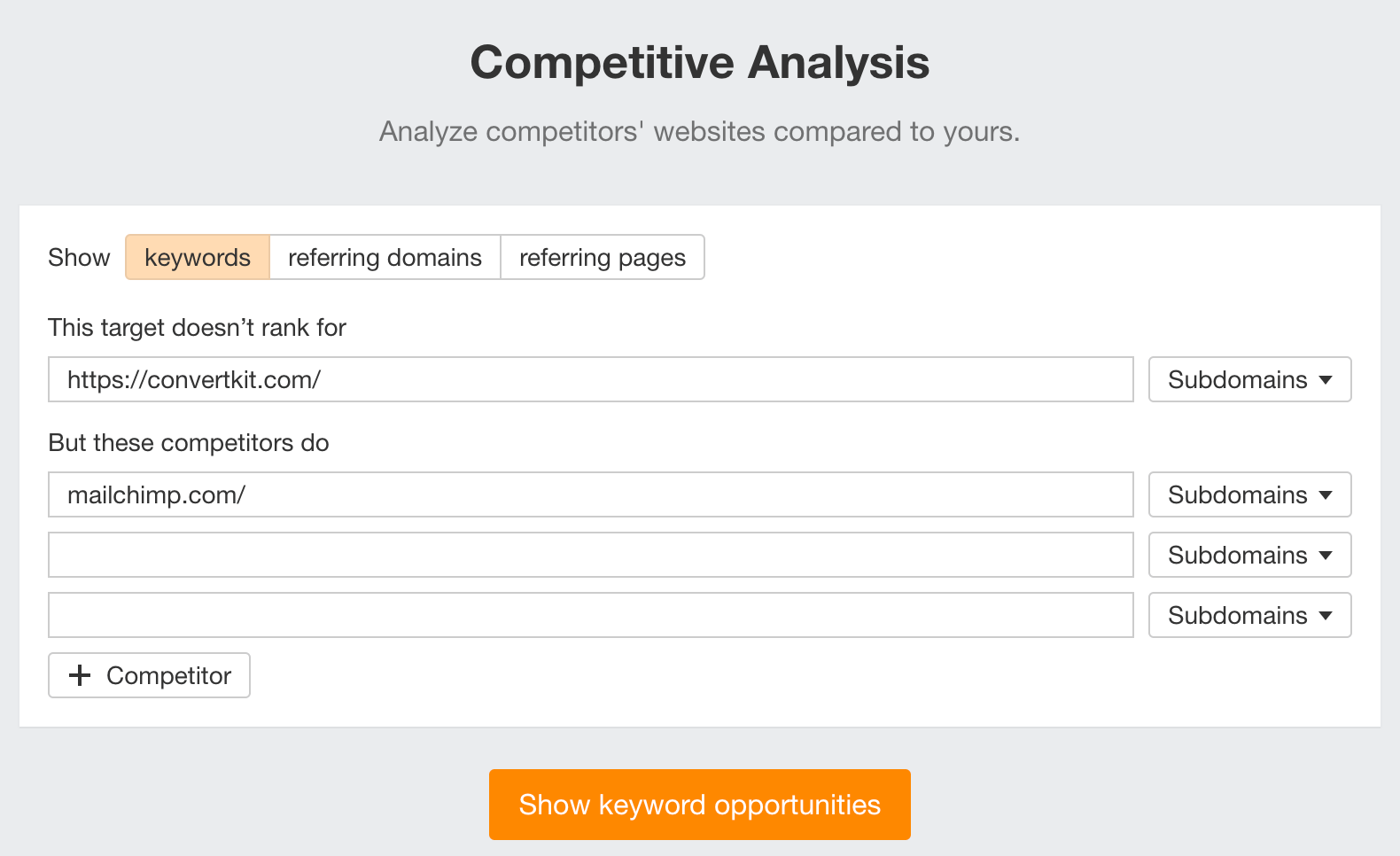

Hit “Show keyword opportunities,” and you’ll see all the keywords your competitor ranks for, but you don’t.
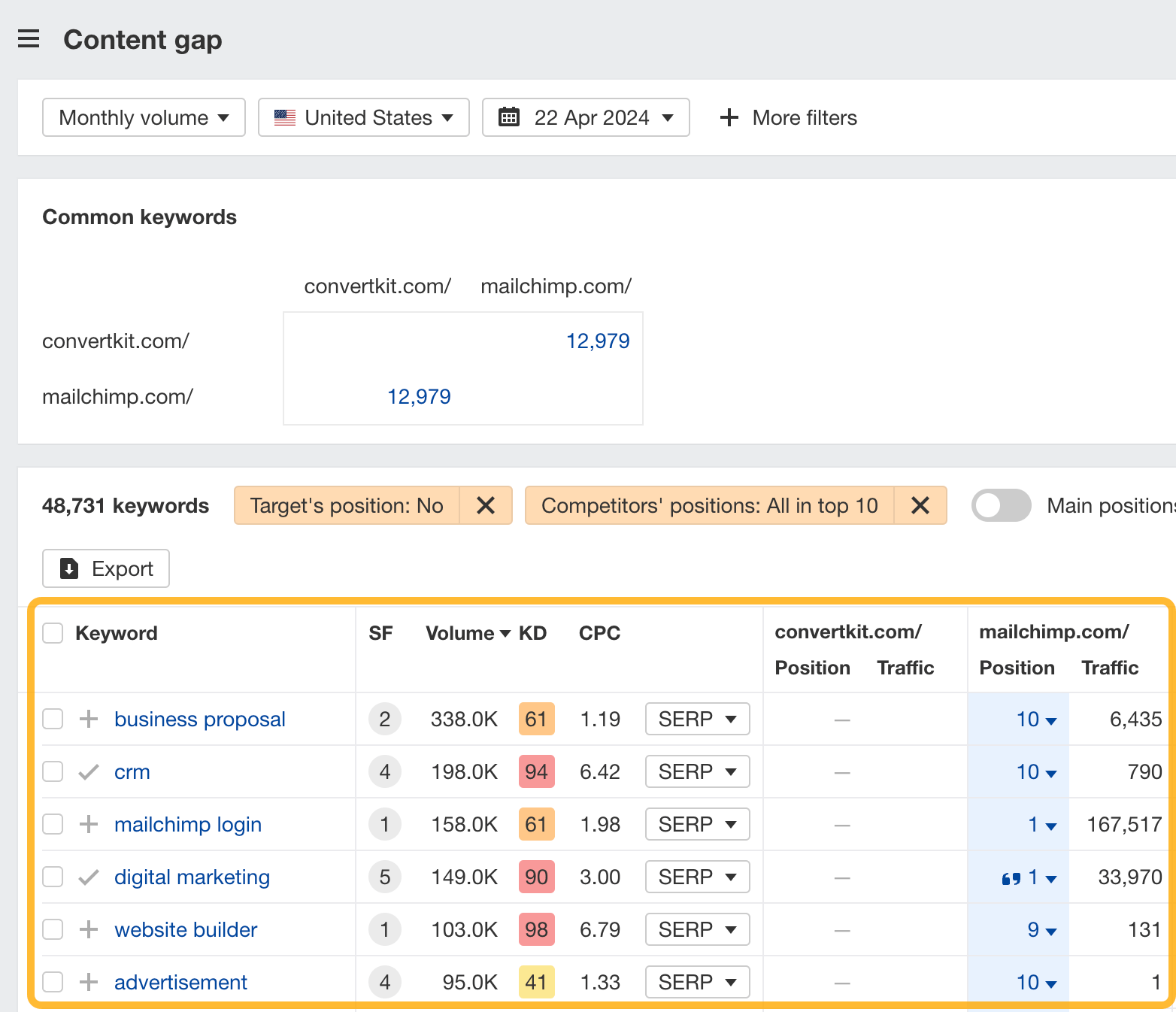

You can also add a Volume and KD filter to find popular, low-difficulty keywords in this report.
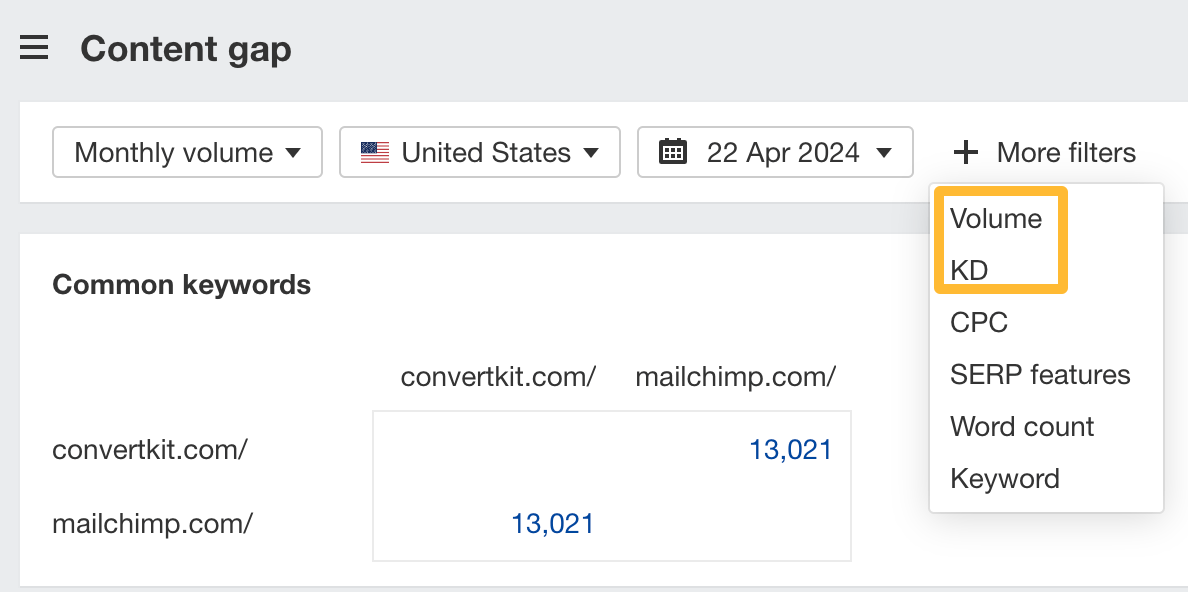

How to find keywords multiple competitors rank for, but you don’t
- Go to Competitive Analysis
- Enter your domain in the This target doesn’t rank for section
- Enter the domains of multiple competitors in the But these competitors do section
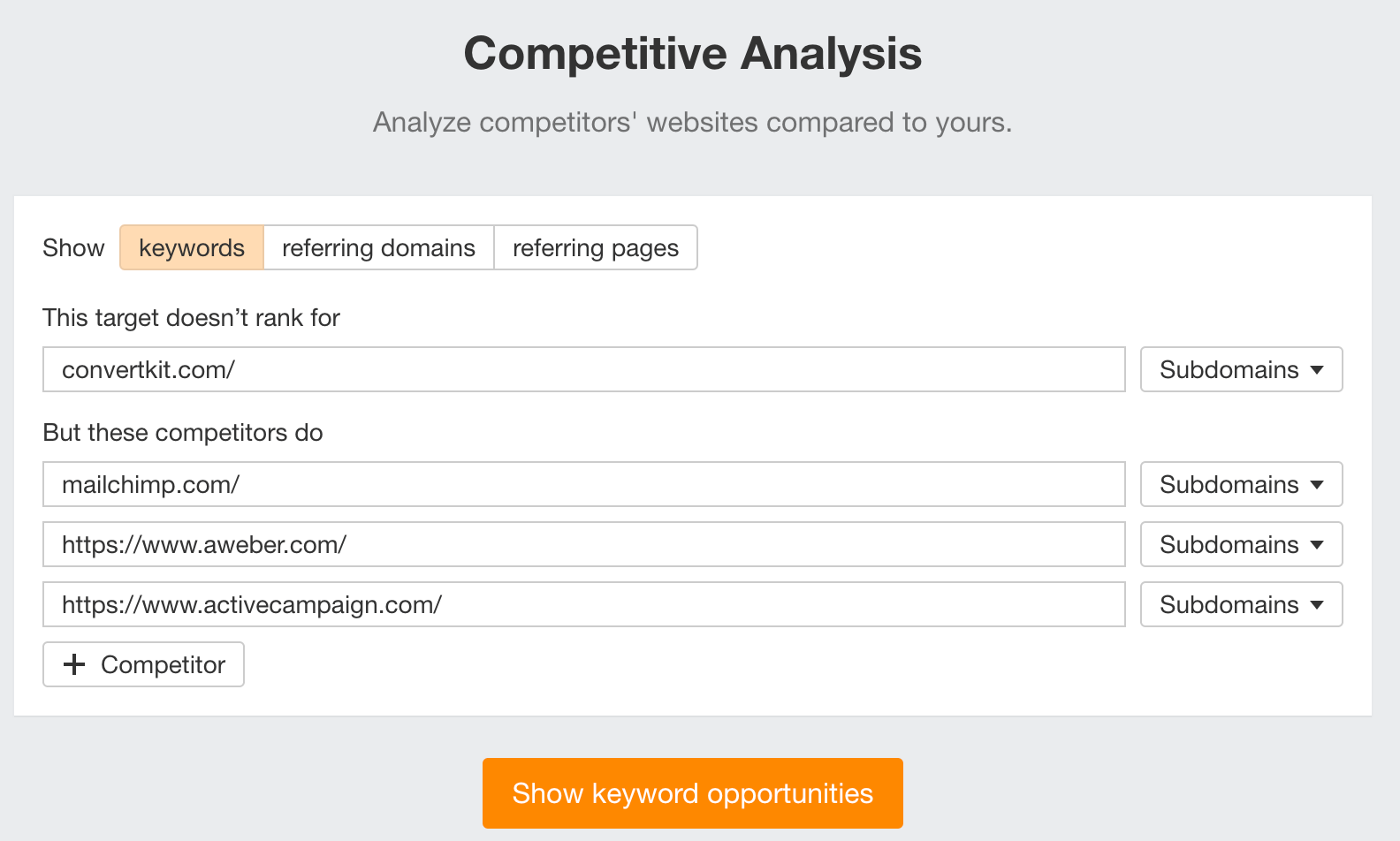

You’ll see all the keywords that at least one of these competitors ranks for, but you don’t.
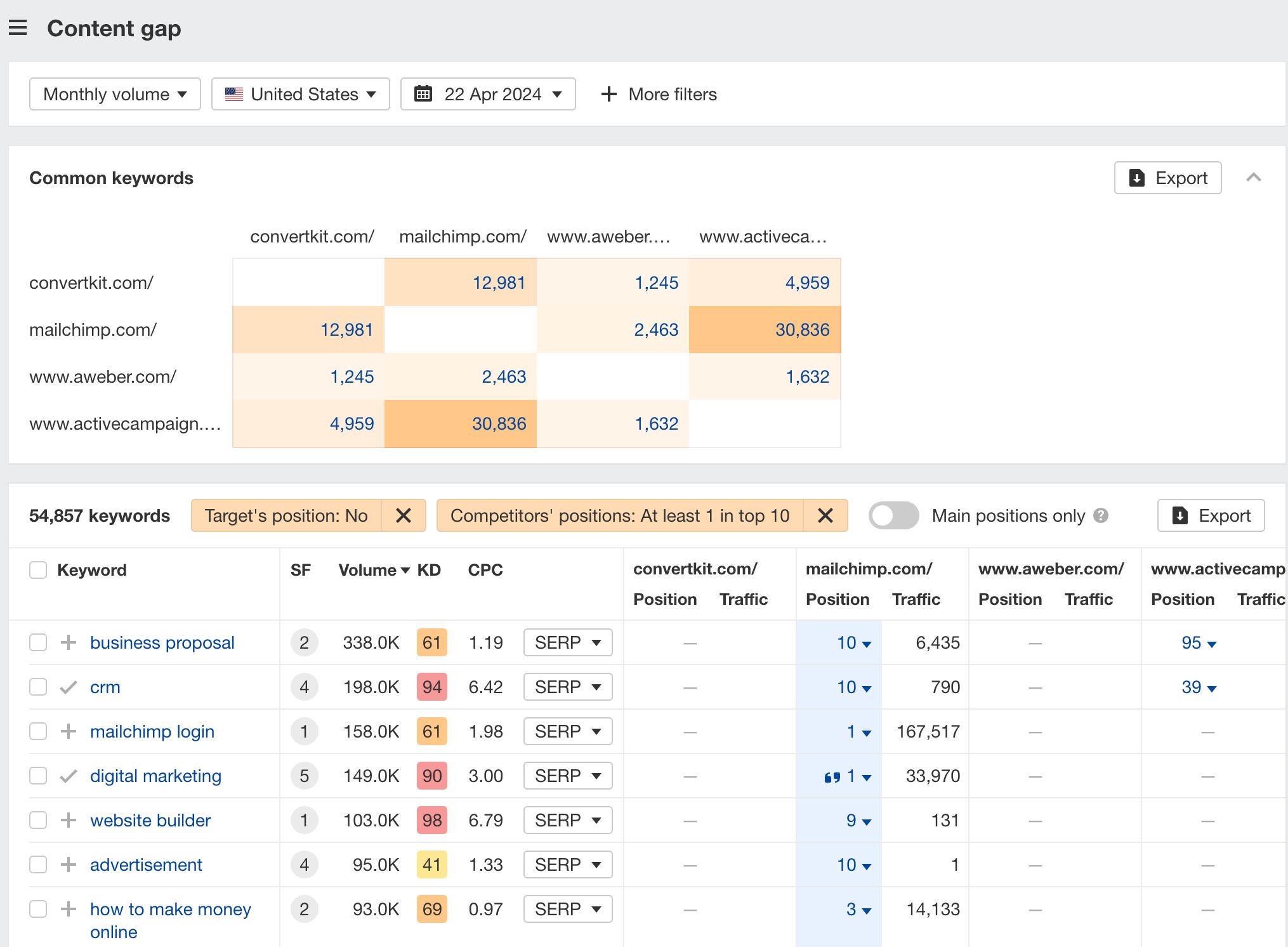

You can also narrow the list down to keywords that all competitors rank for. Click on the Competitors’ positions filter and choose All 3 competitors:
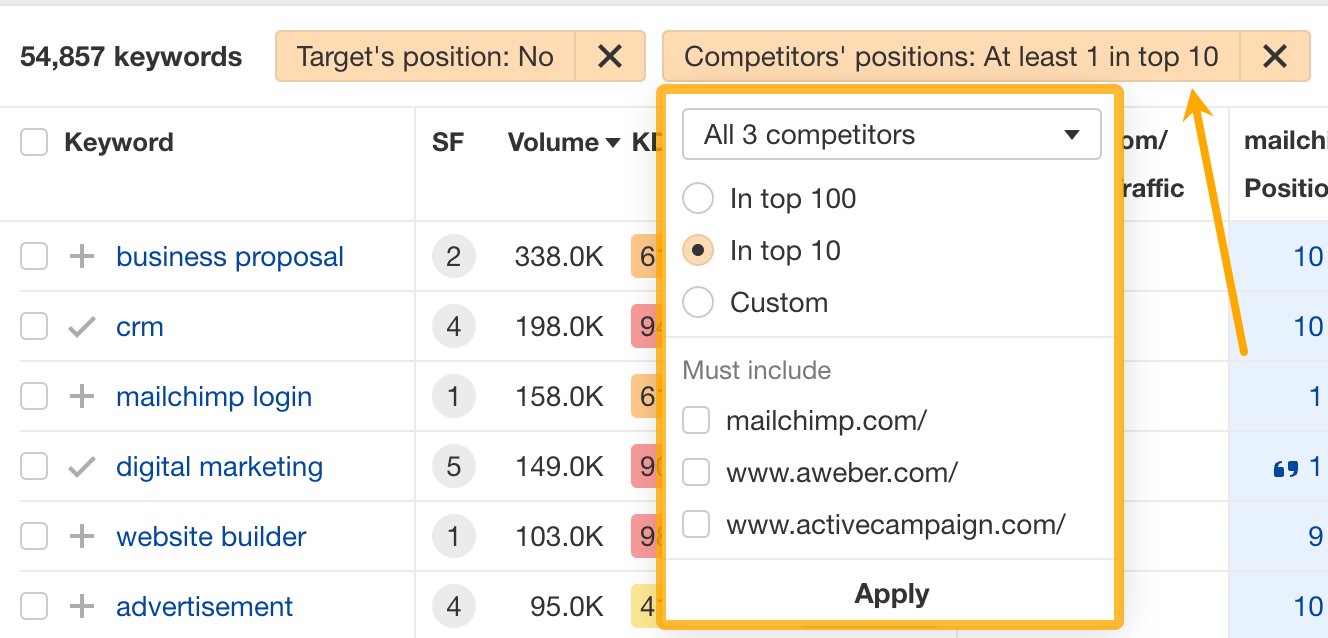

- Go to Ahrefs’ Site Explorer
- Enter your competitor’s domain
- Go to the Paid keywords report
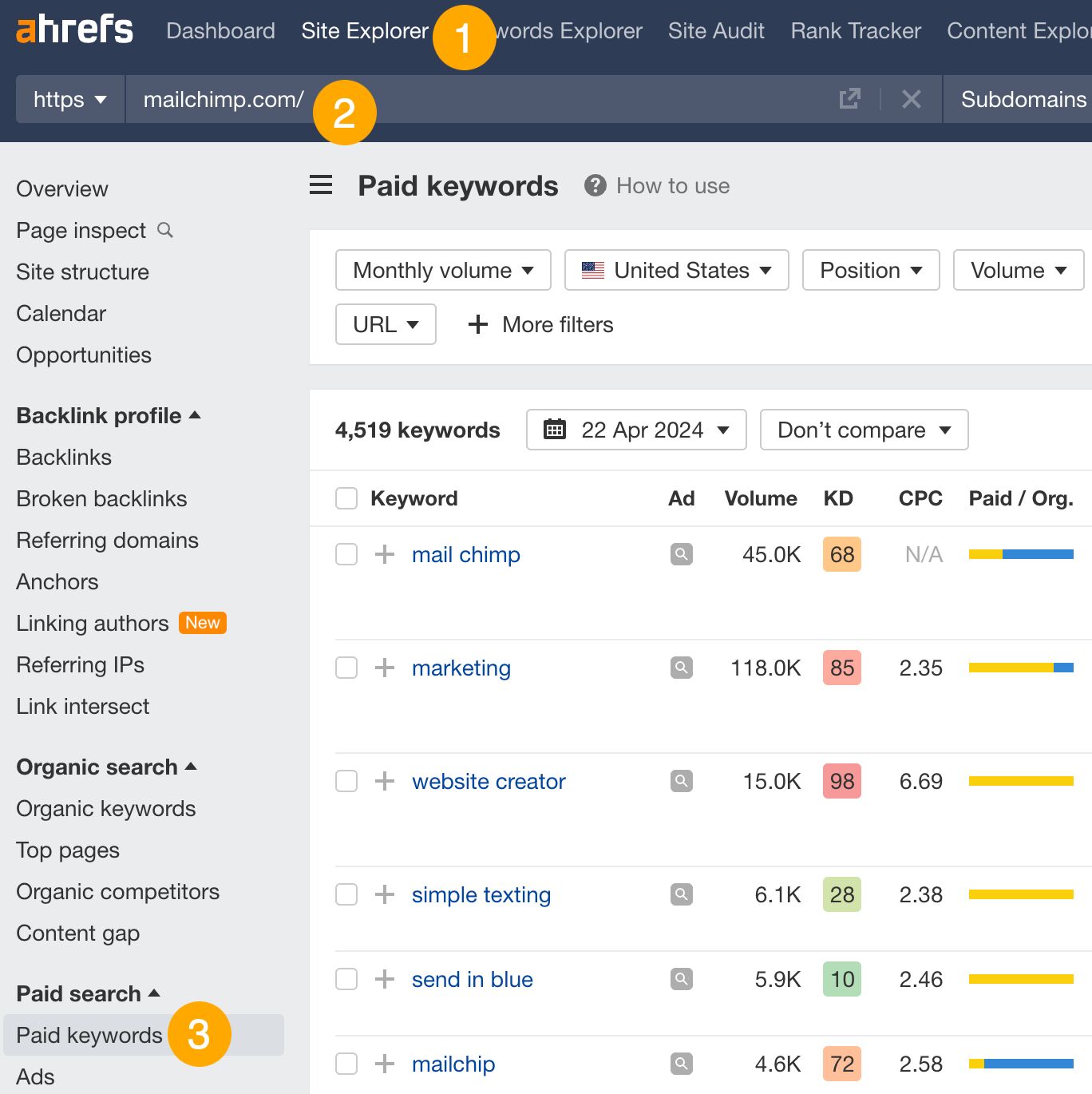

This report shows you the keywords your competitors are targeting via Google Ads.
Since your competitor is paying for traffic from these keywords, it may indicate that they’re profitable for them—and could be for you, too.
You know what keywords your competitors are ranking for or bidding on. But what do you do with them? There are basically three options.
1. Create pages to target these keywords
You can only rank for keywords if you have content about them. So, the most straightforward thing you can do for competitors’ keywords you want to rank for is to create pages to target them.
However, before you do this, it’s worth clustering your competitor’s keywords by Parent Topic. This will group keywords that mean the same or similar things so you can target them all with one page.
Here’s how to do that:
- Export your competitor’s keywords, either from the Organic Keywords or Content Gap report
- Paste them into Keywords Explorer
- Click the “Clusters by Parent Topic” tab
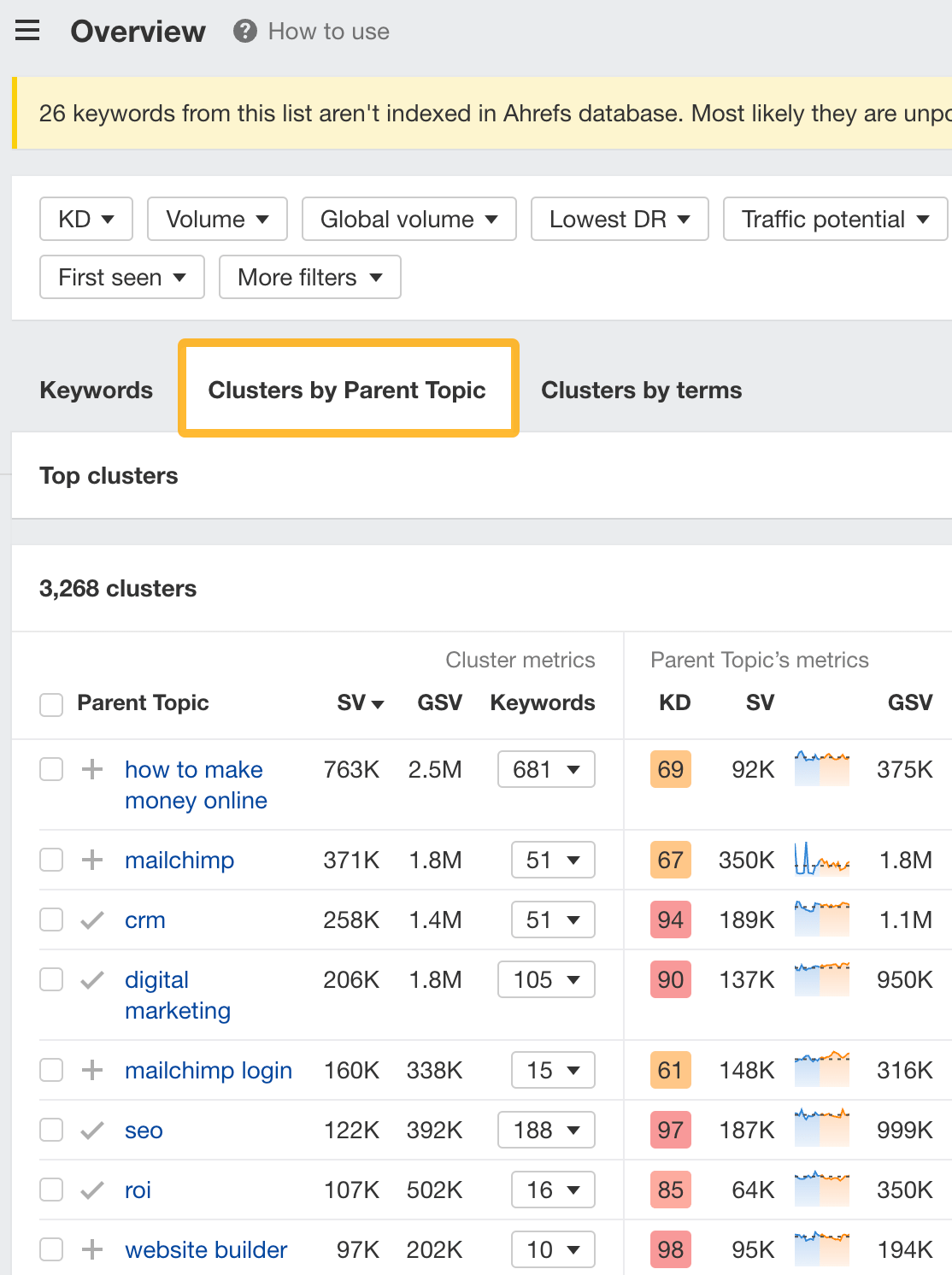

For example, MailChimp ranks for keywords like “what is digital marketing” and “digital marketing definition.” These and many others get clustered under the Parent Topic of “digital marketing” because people searching for them are all looking for the same thing: a definition of digital marketing. You only need to create one page to potentially rank for all these keywords.
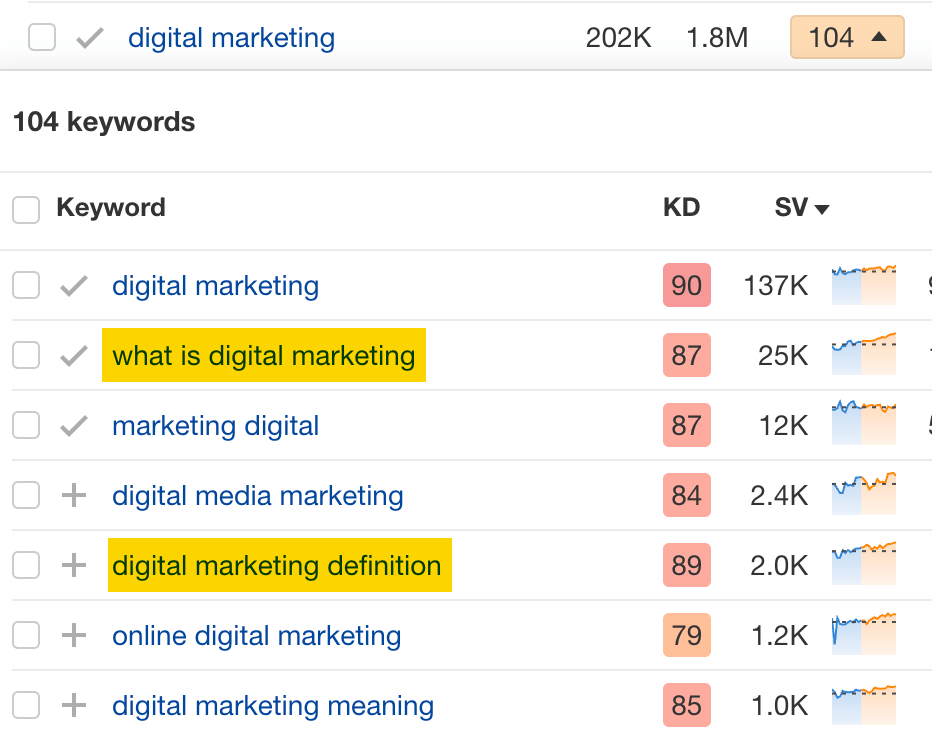

2. Optimize existing content by filling subtopics
You don’t always need to create new content to rank for competitors’ keywords. Sometimes, you can optimize the content you already have to rank for them.
How do you know which keywords you can do this for? Try this:
- Export your competitor’s keywords
- Paste them into Keywords Explorer
- Click the “Clusters by Parent Topic” tab
- Look for Parent Topics you already have content about
For example, if we analyze our competitor, we can see that seven keywords they rank for fall under the Parent Topic of “press release template.”


If we search our site, we see that we already have a page about this topic.


If we click the caret and check the keywords in the cluster, we see keywords like “press release example” and “press release format.”
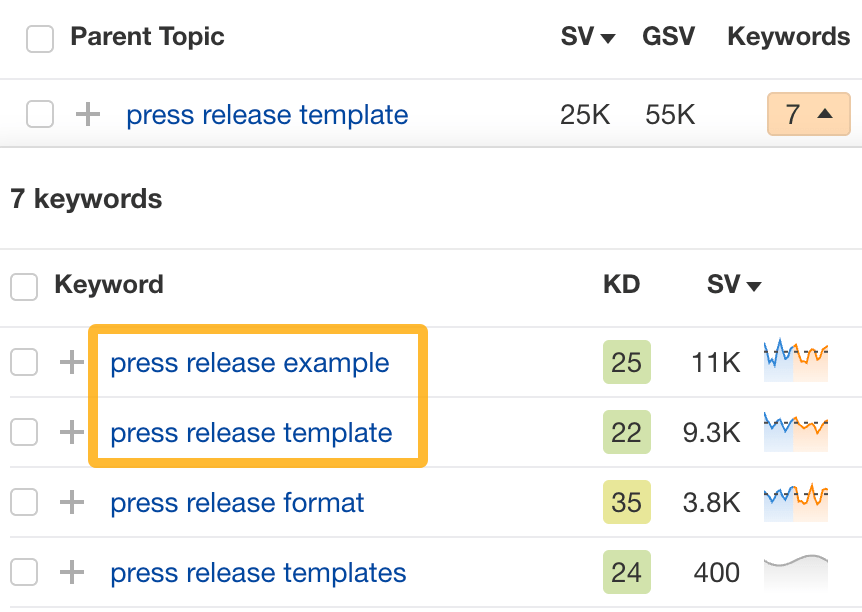

To rank for the keywords in the cluster, we can probably optimize the page we already have by adding sections about the subtopics of “press release examples” and “press release format.”
3. Target these keywords with Google Ads
Paid keywords are the simplest—look through the report and see if there are any relevant keywords you might want to target, too.
For example, Mailchimp is bidding for the keyword “how to create a newsletter.”


If you’re ConvertKit, you may also want to target this keyword since it’s relevant.
If you decide to target the same keyword via Google Ads, you can hover over the magnifying glass to see the ads your competitor is using.
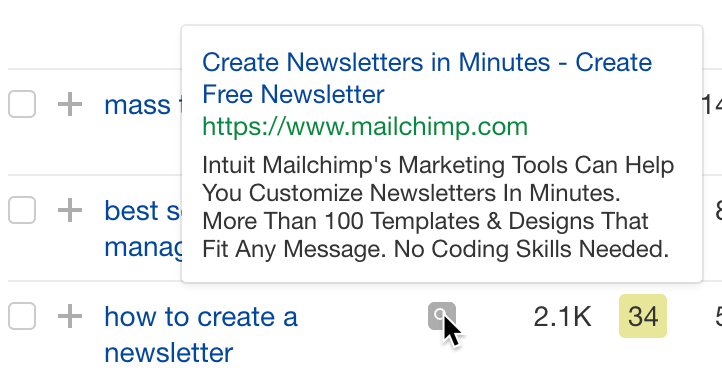

You can also see the landing page your competitor directs ad traffic to under the URL column.


Learn more
Check out more tutorials on how to do competitor keyword analysis:
-

 PPC5 days ago
PPC5 days ago19 Best SEO Tools in 2024 (For Every Use Case)
-

 MARKETING7 days ago
MARKETING7 days agoStreamlining Processes for Increased Efficiency and Results
-
SEARCHENGINES7 days ago
Daily Search Forum Recap: April 17, 2024
-

 PPC7 days ago
PPC7 days ago97 Marvelous May Content Ideas for Blog Posts, Videos, & More
-

 SEO7 days ago
SEO7 days agoAn In-Depth Guide And Best Practices For Mobile SEO
-
SEARCHENGINES5 days ago
Daily Search Forum Recap: April 18, 2024
-

 MARKETING6 days ago
MARKETING6 days agoEcommerce evolution: Blurring the lines between B2B and B2C
-
SEARCHENGINES4 days ago
Daily Search Forum Recap: April 19, 2024











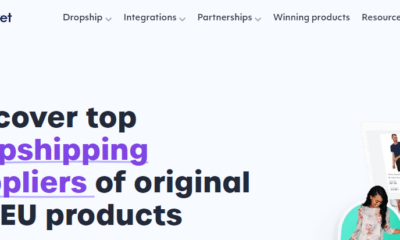





You must be logged in to post a comment Login